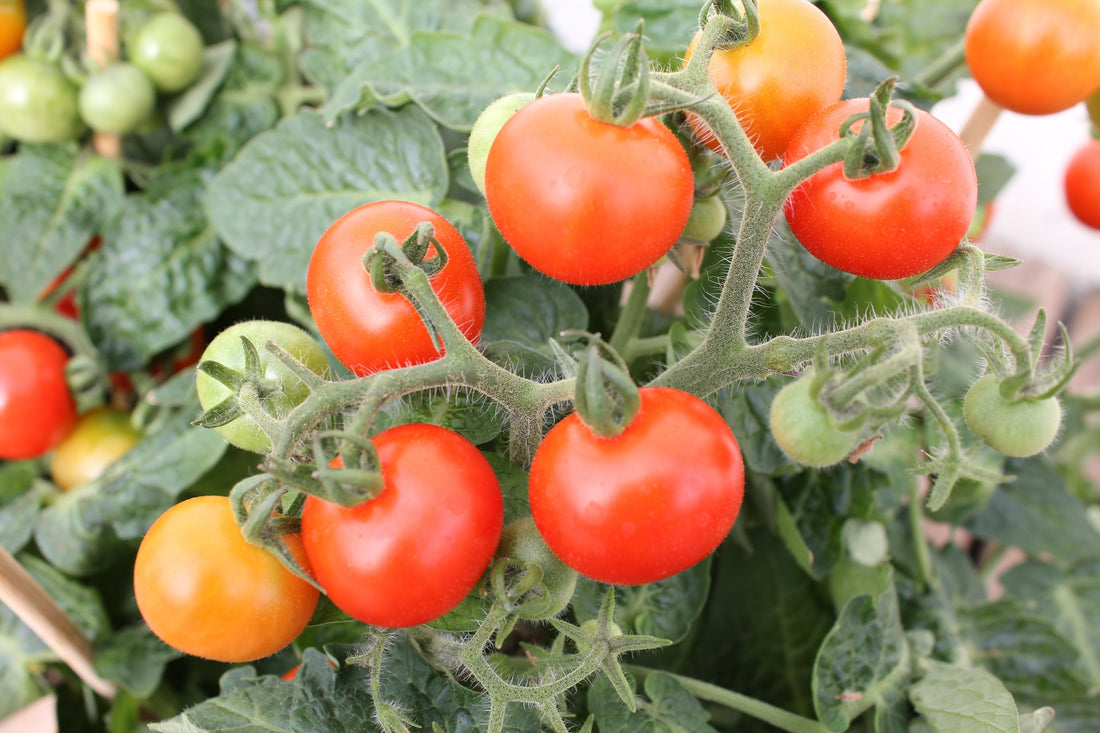Indeterminate tomato plants require more upkeep than determinate; however, they are worth it for their depth and uniqueness of flavor, diversity, quality, and uniqueness. Determinate tomato growth is more compact and contained. Each type has its benefits and drawbacks.
Determinate vs. Indeterminate
Determinate tomato plants, also called bush tomatoes, stop growing at a specific height. They go from flower to fruit faster than indeterminate tomato plants. Determinate tomatoes tend to be smaller and are ideal for small spaces or container gardening. They work well with tomato cages or staking as they are easier to control.
Indeterminate tomato plants don't have a specific height, and many will grow wild and tall if allowed. Some species reach 8-10 feet! Their branches and stem grow out both horizontally and vertically. If they aren't trimmed, they will turn into a tomato vine jungle, and it won't be easy to harvest the ripe tomatoes.
Heirloom tomatoes are always indeterminate plants. These plants produce delicious and flavorful fruits. However, since the plant uses lots of energy on the vines instead of the fruit, they often take longer to mature.
Check out the all the determinate and indeterminate tomato varieties we carry here at Isla's Garden!
Why It Matters Whether You Grow Indeterminate or Determinate Tomatoes
One of the most common problems new indeterminate tomato growers encounter is not allocating enough space for the plant to grow. It isn't easy to imagine just how large and spread out they can get when they are still seeds. They need lots of space, horizontally and vertically.Indeterminate tomato types easily grow 6-8 feet tall and spread out just as wide. Without proper spacing, pruning, and training, adjacent plants will intertwine and create an almost impenetrable wall of green vines.
Indeterminate tomatoes should not, and cannot, be grown in containers. They're too big and unwieldy. But, determinate tomato varieties are perfect for container gardening or gardening in small spaces.
The other big difference between the two tomato types is the fruiting time. Indeterminate tomatoes ripen throughout the season, producing a steady supply of fruits. Determinate tomatoes ripen all at once and must be harvested en masse when they are ready.
How To Support Tomatoes
Indeterminate tomatoes need a support system in place to keep the plants from tipping over or growing along the ground. Their vines get very heavy, especially as the ripening tomatoes increase in size. Without support, the fruit will touch the ground and rot or not grow properly. Determinate tomatoes benefit from a support system, but it isn't always necessary. It depends on the variety.Also, the vines are liable to crack or snap midsection because of the weight. Or, the stem may split as it struggles to hold itself up. Supported plants are healthier and give higher fruit yields.
Trellis systems, wire tomato cages, or wooden stakes are all excellent supports. Trellises or stakes are generally best for indeterminate tomato plants. Wire cages might work if they are at least 6 ft tall and very sturdy. The ones you find at the garden store are usually too flimsy.
If you decide to use stakes, choose ones that are at least 8ft tall. To provide adequate support, they need to be driven a foot into the soil and about 3-4 inches from the plant. This also prevents them from getting blown over in a storm.
Use soft string or cloth strips to tie the branches to the support as the tomatoes grow. Tie them in a figure 8 shape, from the tomato plant to the stake. The stake will be in one loop of the eight, and the tomato stem will be in the other loop. Repeat this as needed as the plants grow taller. The idea is to train the branches to grow upwards instead of outwards and keep all the vines off the ground.
How To Care For Indeterminate Tomato Plants
When your indeterminate tomato plant starts growing, remove competing stems and sucker shoots -- they grow between the leaf stems and the main stem. Several main branches will establish themselves as the plant grows, and the remainder should be pruned. This stops the tomato plant from competing with itself for resources and allocates more energy to fruit production.Suckers, or laterals, grow out the side of the main stem. These need to be pinched off with your fingers, preferably before reaching 3" in length. It is vital to remove the laterals growing at the base of the plant, below the established leaf stem. If they're left unchecked, these can go completely out of control.
How To Take Care of Determinate Tomatoes
Determinate tomatoes grow in a scheduled way. The plants reach a certain height and then stop growing. Once they stop growing, the tomato plants focus their energy on producing fruit. The fruits are ripe and ready for harvest in one to two months; they ripen simultaneously.These tomatoes are ideal for gardeners wanting to make a sauce, jam, or other tomato products since the fruit is all ready at once. This can be a downside, too, if you're not prepared to deal with all your tomatoes at one time. Or if you want to go on vacation right when they're ready for harvest.
When you choose tomato varieties, do your research, and make sure you pick ones that will fit in your space and fit your needs. All tomatoes are either determinate or indeterminate and both give the grower wonderful tomatoes when grown fittingly.



